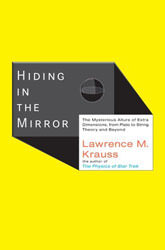
When Lawrence Krauss was a boy he watched an episode of the Twilight Zone in which a girl gets lost in another dimension. Although the show was finished within half an hour the idea of extra dimensions has not escaped the mind of the author ever since. Krauss has become one of the leading experts in cosmology and particle physics as well as a prolific writer of several novels already, the most famous of which is The Physics of Star Trek. It would be difficult to find a better qualified guide to take the reader through the new worlds the book explores.
The first stop is Flatland: the odd world imagined in 1884 by Edwin A. Abbott which has only two dimensions. Krauss explains the philosophical and mathematical underpinnings of the story and describes the scientific research going on during the time by describing the work of contemporaries such as Faraday and Maxwell. He continues by going back and forth between the cultural and scientific viewpoints of the age, which gives the reader a firm foundation in what is needed to understand the later chapters. This method also ensures that the reader does not become bored from too many pages spent on French philosophers for example or too overwhelmed in order to understand the nuances of topics like special relativity. Krauss has also mastered the art of introducing material so a beginner in the subject can understand it with relative ease and also present the information in a fresh way that does not bore a reader already well versed on the topic. In this manner the book progresses through the most important points of modern physics and cosmology in a well-explained and creative manner that will not bore the reader in the least.
The last third of the book is devoted to the most recent cosmological implications of extra dimensions, which includes such exotic topics like quantum mechanics and string theory. The going in these chapters is more difficult simply because of the difficulty of the information presented: you are dealing with topics theoretical physicists spend lifetimes grappling with so the knowledge requires a bit more pause for retrospect on the part of the reader. The topics are still well explained, however, so if you want to gain an understanding of many of the current issues in physics and cosmology you will be hard-pressed to find a better primer.
The book finally concludes with an essay on Krauss’ own views on the topic of extra dimensions, most notably in the area of string theory. After patiently explaining all their possibilities from science to philosophy throughout the book, Krauss admits that he is an agnostic because of the lack of physical proof that science requires by definition. His explanation of the scientific method and the value of skepticism are wonderfully refreshing to any empirically minded reader.
Make no mistake: Hiding in the Mirror, through its writing style and beliefs on the role of science in society, will touch the reader as having more than a few Sagan-like qualities within the text and is certainly one of the best works by Lawrence Krauss to date. It is an enchanting examination of our relationship with worlds hiding just beyond our perception, and will leave any reader with a better understanding of the universes, real or tangible, around them.
Review by Yvette Cendes, an undergraduate physics major at Case Western Reserve University.
Read more reviews online, or purchase a copy from Amazon.com.
